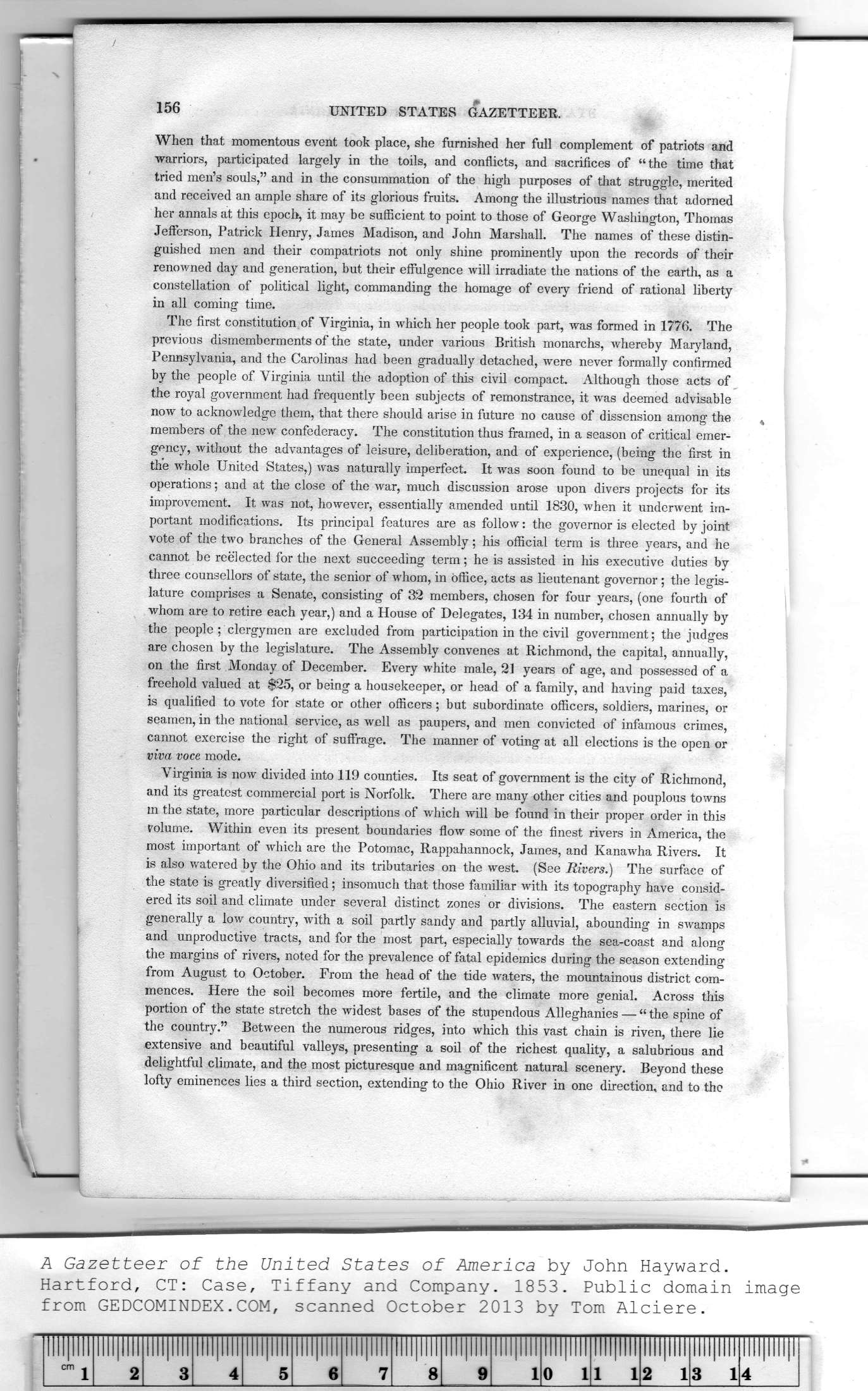Click on the image for a larger version suitable for printing. HOME PAGE ... REFERENCE PAGE ...THIS GAZETTEER’S PAGE |
 |
|
Note: Ctrl and + increases the font size of the text below, Ctrl and - decreases it, and Ctrl and 0 resets it to default size. • 156 UNITED STATES GAZETTEER. i ! / [ j When that momentous event took place, she furnished her full complement of patriots and j warriors, participated largely in the toils, and conflicts, and sacrifices of “the time that tried men's souls," and in the consummation of the high purposes of that struggle, merited I : her annals at this epoch, it may be sufficient to point to those of George Washington, Thomas i Jefferson, Patrick Henry, James Madison, and John Marshall. The names of these distin- ! j guished men and their compatriots not only shine prominently upon the records of their ! renowned day and generation, but their effulgence will irradiate the nations of the earth, as a j f constellation of political light, commanding the homage of every friend of rational liberty I in all coming time. 1 The first constitution of Virginia, in which her people took part, was formed in 1776. The previous dismemberments of the state, under various British monarchs, whereby Maryland, by the people of Virginia until the adoption of this civil compact. Although those acts of . ! now to acknowledge them, that there should arise in future no cause of dissension among the i ! members of the new confederacy. The constitution thus framed, in a season of critical emer- | ! g^ncy, without the advantages of leisure, deliberation, and of experience, (being the first in ; the whole United States,) was naturally imperfect. It was soon found to be unequal in its j ; operations; and at the close of the war, much discussion arose upon divers projects for its | improvement. It was not, however, essentially amended until 1830, when it underwent iin- j portant modifications. Its principal features are as follow: the governor is elected by joint. ! i vote of the two branches of the General Assembly; his official term is three years, and he | cannot be reelected for the next succeeding term; he is assisted in his executive duties by three counsellors of state, the senior of whom, in office, acts as lieutenant governor; the legis- < whom are to retire each year,) and a House of Delegates, 134 in number, chosen annually by the people ; clergymen are excluded from participation in the civil government; the judges ; freehold valued at $25, or being a housekeeper, or head of a family, and having paid taxes, i'i is qualified to vote for state or other officers; but subordinate officers, soldiers, marines, or I ! seamen, in the national service, as well as paupers, and men convicted of infamous crimes, cannot exercise the right of suffrage. The manner of voting at all elections is the open or Virginia is now divided into 119 counties. Its seat of government is the city of Richmond, , and its greatest commercial port is Norfolk. There are many other cities and pouplous towns | m the state, more particular descriptions of which will be found in their proper order in this polume. Within even its present boundaries flow some of the finest rivers in America, the is also watered by the Ohio and its tributaries on the west. (See Rivers.) The surface of j ered its soil and climate under several distinct zones or divisions. The eastern section is j generally a low country, with a soil partly sandy and partly alluvial, abounding in swamps " and unproductive tracts, and for the most part, especially towards the sea-coast and along ; the margins of rivers, noted for the prevalence of fatal epidemics during the season extending , from August to October. From the head of the tide waters, the mountainous district com- ; mences. Here the soil becomes more fertile, and the climate more genial. Across this i portion of the state stretch the widest bases of the stupendous Alleghanies — “ the spine of ! the country." Between the numerous ridges, into which this vast chain is riven, there lie extensive and beautiful valleys, presenting a soil of the richest quality, a salubrious and \ lofty eminences lies a third section, extending to the Ohio River in one direction, and to the
|